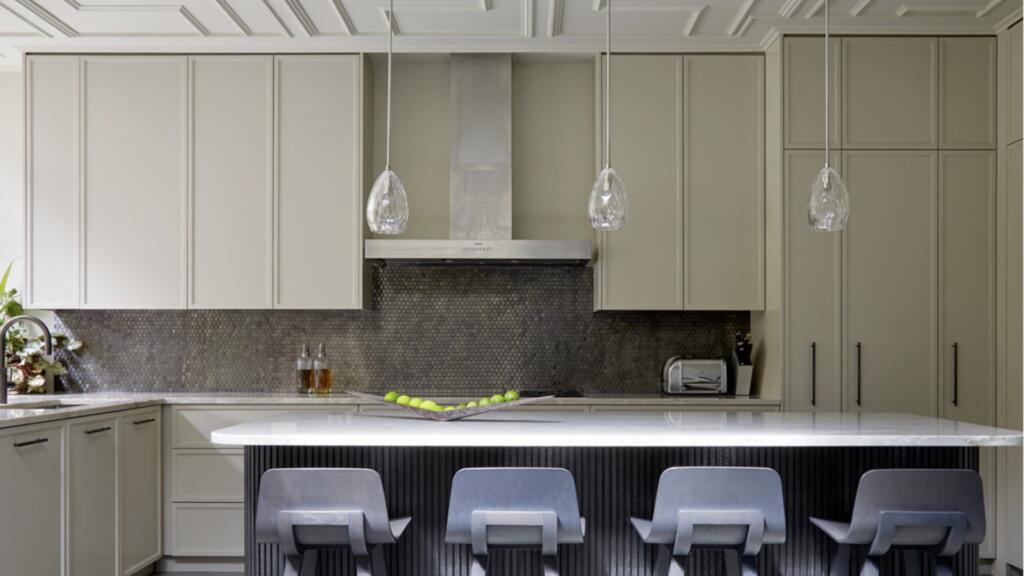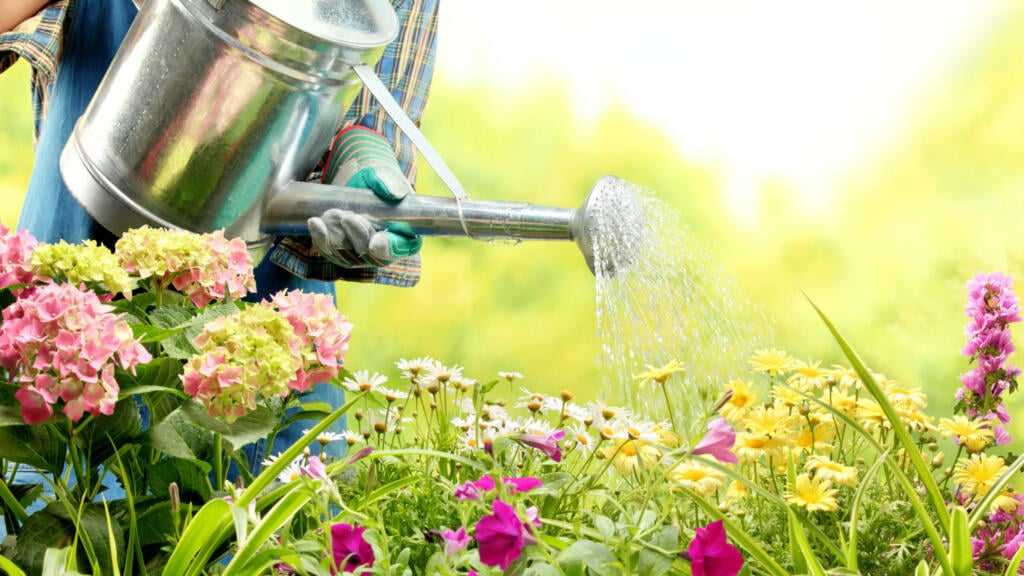
17 brilliant ideas to make your kitchen a happy place
Joy Archer
From edibles to easy care, there’s a plant to suit all tastes.
Nothing adds more new life to your home than a freshly potted plant. Colourful, textural and oozing with wellbeing qualities, a houseplant is more than a prop. And simply visiting your local garden centre to browse their selection can bring a feel-good boost to your day.
But speaking from experience of a variety of foliage failures, it’s clear not all specimens are suitable for every room.
While it’s easy to understand that some plants prefer a darker environment and others thrive in light and moisture, if your green fingers have never quite passed the nursery stage, just what makes the cut when it comes to kitchen plants?
Nothing adds more new life to your home than a freshly potted plant. Colourful, textural and oozing with wellbeing qualities, a houseplant is more than a prop. And simply visiting your local garden centre to browse their selection can bring a feel-good boost to your day.
But speaking from experience of a variety of foliage failures, it’s clear not all specimens are suitable for every room.
While it’s easy to understand that some plants prefer a darker environment and others thrive in light and moisture, if your green fingers have never quite passed the nursery stage, just what makes the cut when it comes to kitchen plants?
 Credit: Patch Plants
Credit: Patch PlantsWith the help of some expert advice, we’ve rounded up 10 of the best kitchen plants to breathe new life into the heart of your home.
 Credit: Dobbies
Credit: DobbiesResearch from Dobbies and Censuswide found that, of the 2,004 UK residents they surveyed in March 2023, 73% planned to grow their own fruit, vegetables or herbs this year, with almost half citing better tasting produce as a driving factor for this lifestyle decision.
This led the garden centre chain to think about how everyone should be able to benefit from the wellbeing benefits of cultivating crops.
As a result, a new windowsill friendly range includes tomatoes, peppers and strawberries, giving everyone, including city dwellers, the chance to grow their own produce.
Claire Bishop, senior houseplant buyer at Dobbies, says: “The tomato plants are ideal for growing on a bright windowsill, and since they come bearing fruit, you can enjoy delicious tomatoes straight away.”
Although the plants can be placed outside during the summer months, it’s not necessary, as they are self-pollinating. There’s also more good news. “If your windowsill gets enough light and warmth,” says Bishop, “they’ll continue to grow well into autumn.”
Normally found in more tropical climates, peace lilies are both beautiful and practical as a kitchen plant.
Adding an elegant and refined feel, they also help combat the risk of mould by, absorbing excess moisture from the air.
 Credit: Happy Houseplants
Credit: Happy HouseplantsChris Bonnett from Gardening Express explains how this works: “How good a plant is at reducing humidity is all to do with its ability to absorb dew, fog and other moisture through its leaves. This moisture then moves down to its roots.
“The peace lily loves the shade, and thrives in high humidity,” adds Bonnett. “It absorbs moisture through the air through its leaves and doesn’t need direct sunlight to thrive.”
Assume that exotic means high-maintenance? Don’t be fooled into thinking a plant as beautiful as this needs special care.
“Peace lilies are also remarkably easy to look after,” says Emily Lawlor, owner of RHS Chelsea gold medal winning Happy Houseplants. “For something so exotic looking, keep them in a semi-shaded position and you’re on the right track.
“A lot of people assume that tropical plants must like full sun,” adds Lawlor, “but generally, with rainforest plants that’s not the case. The forest provides lots of shade, so many plants prefer not to be in the full glare of the sun.”
Although this plant may have beautiful white flowers, it can be toxic to pets so make sure you keep it out of their way.
With their delicate beauty and ability to bloom again, orchids can bring year-round joy to your kitchen. It’s even one of the plants I’ve managed to nurture in my own home.
 Credit: Dobbies
Credit: DobbiesBut how do you ensure it isn’t just a one-bloom wonder? We asked Bishop for her top orchid care tips.
“Placing your orchids in bright, indirect light will help them to thrive,” she says, “and keeping the roots in good condition (not too wet or too dry) is the key to success with these houseplants.
“Orchids don’t like to be too wet,” she adds, “so be careful not to over-water or leave them standing in water, as this will cause their roots to rot. Instead, aim to water them just before their potting mix dries out.”
Keeping the temperature above 16C (61F) is another top tip, and don’t forget to give them a healthy prune once the blooms have gone.
“When your orchid has finished flowering,” adds Bishop, “prune the stems by cutting off the stalk as low as possible. This will keep your plant in tip-top condition by allowing a new flowering side shoot to take its place, sprouting from the base at the next flowering cycle.”
Can I use any fertiliser for my orchids?
While most good potting mixes will help to grow a happy and healthy orchid, specific orchid compost is preferable. Bishop advises fertilising the compost mix weekly between March and September to maximise your beautiful blooms.
Although plants in general are well known for their ability to generate cleaner air, the slightly messy appearance of the spider plant makes you wonder if it’s up to the job.
 Credit: Gardening Express
Credit: Gardening ExpressIf you did think that, you’d certainly be wrong. Behind the leafy fronds of green lie superpowers – it’s is one of the best plants at removing pollutants from the air.
How do we know? A clean air study by NASA revealed that spider plants removed 95% of pollutants from the air in 24 hours. So if it’s clean living you’re after, you won’t go far wrong by adding a spider plant or two to your kitchen collection.
If, like me, you struggle to know just how much water a plant needs, the company Patch Plants offers a simple tip for checking how thirsty your spidery friend is:
“A good way to check if it needs watering is to dip your finger into the soil, up to the second knuckle. If your finger comes out clean and dry, it’s time to water your plant,” it says.
Well known for its ability to soothe sunburnt skin and also available in consumable form to help with digestion issues such as constipation, the aloe vera plant can also be beneficial to your psychological wellbeing.
 Credit: Happy Houseplants
Credit: Happy Houseplants“Aloe vera plants are great mood boosters,” says Lawlor. “Sculptural and relaxing to look at, they are also low-maintenance.
“Houseplants have been shown to have a positive impact on mental health by reducing stress and anxiety and improving mood,” she adds. “This can help promote wellbeing and a sense of connectedness with the natural world.”
Aloe vera plants come in many sizes – the smaller versions are ideal for popping on kitchen shelves.
Placement is an important consideration for some plants, and Lawlor tells us people can make a common mistake when it comes to plants such as aloe vera.
“Always remember that unless your kitchen plant is a specific herb or vegetable, you should never assume a plant is edible.
“A prime example is when people assume they can eat an aloe vera plant,” she explains. “Although aloe vera has medicinal properties and is used in health and beauty products, consuming the plant can be harmful.” It therefore might be a good idea to keep it out of reach of pets and curious children.
Lawlor shares her top tips for ensuring your kitchen houseplants thrive.
“Keeping houseplants alive and healthy requires a bit of knowledge and effort, but the rewards are well worth it.
“By choosing the right plant, watering properly, providing the right amount of light, keeping your plants clean, providing proper ventilation, keeping pests away, and repotting them when necessary, you can ensure that your houseplants thrive and add beauty to your home for years to come.”
Pink dragon plants have soft pink stems and burgundy undersides to their heart-shaped leaves, adding a delicate burst of colour to your kitchen plant collection.
 Credit: Happy Houseplants
Credit: Happy HouseplantsAlthough the pink dragon hails from a tropical environment, its dark green leaves are not a fan of direct sunshine and can become scorched if overexposed to the sun. This can make the leaves dull. The pink dragon is more comfortable in a space where there’s a little more moisture.
“The pink dragon likes bright, indirect light,” says Lawlor, “so we recommend west-facing windows in order for it to thrive.” She also recommends popping it on a tray of pebbles that are kept well-watered to give this rare plant an extra boost of moisture.
Another one to avoid if you have pets, as it is considered toxic to some.
Named because of its long strands of foliage adorned with small green pods, the string of pearls belongs to the succulents group of plants.
 Credit: Happy Houseplants
Credit: Happy HouseplantsFound in its native form in southwest Africa, string of pearls is a low-maintenance plant that looks just as good when grouped together on a shelf as it does hanging individually from a safely installed ceiling hook.
But be warned – its strands can grow up to two to three feet (up to a metre) in length, so you’ll need to make sure it’s not positioned anywhere near your food preparation area.
Preferring indirect light and well-draining soil, this is not a plant that will enjoy being over-watered. Instead, Happy Houseplants advises that “[strings of pearls] are susceptible to root rot if over-watered. It’s best to allow the soil to dry out between waterings, then water thoroughly and let the excess water drain out.”
What are succulents?
According to the Encyclopedia Britannica, a succulent is:
“Any plant with thick fleshy tissues adapted to water storage. Some succulents store water only in the stem and have no leaves or very small leaves, whereas others store water mainly in the leaves. Most succulents have deep or broad root systems and are native to either deserts or regions that have a semiarid season. Succulent plants are found in more than 60 plant families.”
Like windowsill friendly tomato plants, herbs are another kitchen plant staple than can add to your culinary delights .
Their wonderful and fragrant aromas can also be a great way of combatting any nasty whiffs caused by stale cooking smells.
 Credit: Unsplash/Kevin Doran
Credit: Unsplash/Kevin DoranJulian Palphramand, head of plants at British Garden Centres, tells us that we shouldn’t be worried that it’s complicated, as “growing herbs in your kitchen is a breeze”.
“Pick a windowsill that gets four to six hours of sunlight, preferably a south or southwest-facing one,” he says. “Keep sowing batches every few weeks, and you’ll have a regular supply for the kitchen in no time.”
Perfect for Italian food, an easy aromatic to grow that needs soil that drains well and lots of sun.
These have an oniony taste and are a must-have for sprucing up potato salad, cream cheese, soups and other savoury dishes.
A herb that grows fast with a big flavour and is often used in Asian dish.
An amazing addition to roast lamb, salad, baby potatoes or summer cocktails.
A perennial herb with small highly scented leaves to add zest to poultry, meat and game dishes, and ideal for flavouring soups.
For a practical but stylish approach to your herb window garden, why not place them in a vintage wooden crate and line the bottom with newspaper to prevent any soil spilling onto your kitchen surfaces.
Wooden vintage herb garden crate, £10, MatalanOffering practically foolproof maintenance, and often smaller in size, cacti can be a great addition to a compact kitchen.
Whether clustered together on worktops or used to create a windowsill display, they are an undemanding house guest, asking for little more than plenty of light and the occasional drop of water.
 Credit: Patch Plants
Credit: Patch PlantsAccording to Patch Plants, they’ll even make it clear when they need water by wrinkling up their leaves. It’s a sign I’ve failed to wait for in the past, assuming that they need a drink way before they’re actually dry.
There’s also no doubting their ability to stand the test of time, according to Birmingham Botanical Gardens, which says that cacti are as old as dinosaurs.
According to facts displayed on its website: “Although the exact date of when cacti sprouted will probably never be known, it is estimated that they emerged during the Cretaceous period, up to 110 million years ago.
“In Park S. Nobel’s text, Cacti: Biology and Uses, it is indicated that cacti evolved shortly after the supercontinent Gondwana segmented into smaller continents, which included the cacti homeland of South America.”
If you’re a lover of talking to your plants, just imagine the ancestral stories your cacti could share if they could only talk back to you!
If you have a bright and sunny kitchen, add a vibrant, zesty lemon tree to your kitchen plant display.
 Credit: Patch Plants
Credit: Patch PlantsAlthough the winter months may see less activity, care for your lemon tree well and in late spring you’ll be rewarded with fragrant white blossoms that signify the start of your lemon growth.
As the months pass by, these little white flowers will grow and turn into luscious lemons, just in time for a cool gin and tonic in the summer sunshine.
Although there aren’t many citrus trees that thrive in Britain, Patch Plants says that when placed in a bright spot, “a lemon tree that’s well looked after will fruit until early autumn”.
Patch Plants advises you not to be alarmed if the lemons are initially green. They will eventually ripen after some time in the sun but be aware that not every fruit will ripen to full maturity.
However, as soon as a lemon is yellow, plump and ripe, you should cut it off so that the lemon tree can put its energy into growing more.

Written by Sarah Harley she/her
Published: Updated:
Since first picking up a paintbrush and experiencing the joy of re-decorating her bedroom in a questionable red, white and grey scheme as a young teenager, Sarah Harley was hooked on the world of interior design. This obsession even led to a real life ‘Grand Designs’ project in 2005 when she donned a pink hard hat and appeared on TV screens, project managing the renovation and extension of a Grade II listed 17th century Folly in South Wales.
Throughout her career, Sarah has gained an array of experience in several different roles, ranging from copywriting, PR, events management and photography to interior design and home staging. With her two passions being the written word and the joys of a beautifully designed home, Sarah’s mission is to open the door on the world of interiors, inviting readers in to help them work their way through the vast choice of products, ideas and trends so that their own homes can reach their full potential.

Joy Archer

Rosanna Spence

Rosanna Spence

Camilla Sharman